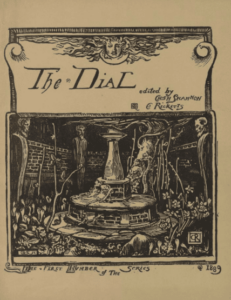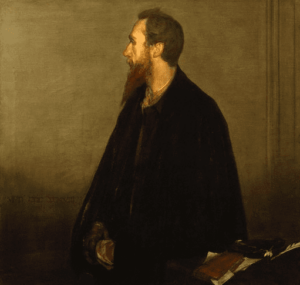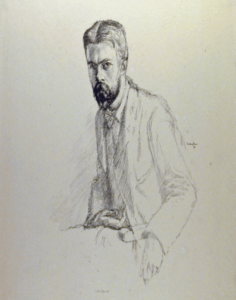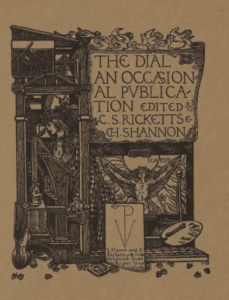The Dial, Charles Ricketts and Laurence Housman, “A Glimpse of Heaven” and “Open the Door, Posy!”
©Copyright 2018 Patricia Lucreziano, Ryerson University
Introduction
I will be curating the stories, Glimpse of Heaven, Vol. 1, pages 19-22 and Open the door, Posy! Vol. 5, pages 4-7 in the Y90s magazine The Dial to better understand the fascination with death and afterlife of a female child. The genre of both of these stories is folklore. As they both lack the fantastic and fairy tale elements.

To summarize Glimpse of Heaven, it is about a little girl who is more or less taking care of her father more than he is taking care of her. Having to receive help from others rather than her own father. They are not wealthy and by the end of the story, the Lord comes to take her as it “must the day of judgment” (Ricketts 21). She was worried about what her father would do without her which simply says so much about her vital role in the running of the household. The Lord then turned her into a beautiful blue flower and placed her on his throne of flowers and she was finally at peace.
Open the Door, Posy! is another story about a family that is in poverty but instead of the Lord coming to save them, Death and the Undertaker came to Posy and her mother’s door with a coffin. The agreement was for them to steal a loaf of bread of Death, the Undertaker, taxman, and Death of Sexton. Posy’s mom had money to buy them more bread whilst being in the coffin half buried, and they were able to bargain with them but finally accepting where they have been placed and Posy and her mother stayed in the coffin in the end after the evil forces moved on.
About The Authors
Charles De Sousy Ricketts

Charles De Sousy Ricketts was born in the year of 1866, in Geneva. Charles De Sousy Ricketts passed in the year of 1931, but where he passed is not known for sure.
Charles Rickett’s co-founded The Dial: An occasional Magazine, in 1889. He was a devoted editor and he published his own work in The Dial as well. He focused his time to produce a painting, sculptures, theatre design, jewelry, art criticism – and eventually to fiction and memoir.
His life-partner was the painter and lithographer Charles Shannon, in which she was a vital piece of the equation in regard to the growth of himself as an artist because she was there to help him along the way
Rickett’s was received positively and as Clark writes in his memoirs, that Charles was a figure of “real distinction” and “much of his work… will be ‘rediscovered’ with astonishment.” Therefore, not only was he positively received in the 1890s, he continues to be well received as we know because many people study him and his works.

Laurence Houseman
Laurence Houseman was born in the year 1865, in rural Worcestershire. Laurence houseman unfortunately passed in the year of 1959, in Somerset.
Houseman has illustrations in The Yellow Book and has pieces of literature work in The Dial as well. The financial stability that was provided from when he became to grow more popular once he focused on more poetry and fiction allowed himself to get into the risky world of theatre and in turn wrote and produced plays, such as Bethlehem: A Nativity, and from there his presence in that world continued to grow. He published eighty of his own books. And left a significant legacy of book design for works by fin-de-siècle writers.
It was in 1890 when he met Charles Ricketts who pushed him to move away from his rookie artwork and to really take that deep dive into the art world. After that, his career seems to grow and he gains a platform at that time. Aubrey Beardsley is the person who was the connection in getting his artwork in The Yellow Book.
Laurence Houseman was extremely positively receipted by society and that is why his career grew so well. He was also involved in Women’s politics which only made him more accepted and loved by all, an advocate for sexual freedom and sexual tolerance, and with that being said it again only more so gives him the opportunity to be received positively by his society.
The Afterlife of a Female Child
In both of these stories in The Dial, an impoverished female child is the protagonist. Both these stories have to do with religion and who one meets their judgment day comes. To compare and contrast we see that in Glimpse of Heaven is a happy ending to her poverty and trouble with the Lord bringing her with him to Heaven. In contrast to Open the Door Posy! where they met Death and the Undertaker, evil beings who subjected them to their fate after scavenging for a loaf of bread. The aspects of my stories that are what make the most impact in regard to religion and fate after doing what one has to do to survive in poverty bring up the cultural issues of the time. Its interpreted as life is not fair and your fate is chosen by forces greater than us. I believe symbolism is a key factor in the works that I am looking in to. Religious symbolism is a very powerful tool and is used very effectively in the two pieces of work that I am responsible for curating. This aspect of the 1890s is important because symbolism is used in the majority of the stories in The Dial and if not all of the other little magazines so with that being said, symbolism is crucially important and relevant to “A Glimpse of Heaven” and “Open the Door, Posy!”
These stories are meant to take the innocence and purity of a child and burden them with the harsh realities of the world. I have come to learn that the works in The Dial are more so folklore and fantasy, and although these stories are considered folklore, the elements of the stories mimic some fanatical elements. Therefore, in attempts to refer to religion, I believe that the fascination with death in the time period stems from the fascination with religion and the wonder of what happens to the soul after death despite your best efforts or lack thereof to sit on the throne of the lord.
The parallel between decadence and the 1890s is quite relevant to the theme of these stories. Ian Fletcher wrote the book called, decadence and the 1890s. Fletcher writes that,
The decadent is a man caught between two opposite incompatible pulls: on the one hand, he is drawn by the world, its necessities, and the attractive impressions he receives from it, while on the other hand, he yearns towards the eternal the ideal and the unworldly. (Fletcher 25)
With saying that it is apparent that the stories being curated fall under the eternal and unworldly of decadence. The focus of these stories having a religious background and leading into the eternal life after death or lack thereof is also relevant to the fascination with death at the time. We can understand that the fascination comes from the decadence of the 1890s.
Found in the Encyclopedia of Victorian Literature, under “The Body” it gives us information on the Victorian culture and how it has a realistic aesthetic and when it comes to anything “emotional and psychological life, and spiritual experience, as well, were imagined.” (Zemka 147). This goes hand in hand with the spiritual experience that the two female protagonists go through in these stories. This encyclopedia helps the reader understand that in Victorian culture, these types of beliefs and stories were known not to happen and that they were purely imaginary in terms of the belief of the capability of the Lord and the Undertaker.
The Cult of the Female Child and Their Roles

The female children in these stories are relied upon, on, have roles and stresses of an adult and are clearly not leading the life of a child. They are both subjected to poverty with their parents being reliant on their company for psychical, emotional and psychological support. In the text Myths of Innocence and Imagination, written by Jeanette Sky, she touches upon the child and the role of said children in Victorian culture, specifically female children. States, “childhood was related to innocence and hence to Paradise” (Sky 368). This quote is relevant to A Glimpse of Heaven because heaven is usually compared to and regarded to as a “Paradise” and the female child who passes is met with the Lord and her innocence is essentially rewarded and she is taken to Paradise (heaven).
The contrast comes in when talking about Open the Door, Posy! In this story, the ending is not rewarding of the child’s innocence but she and her mother are subjected to meeting the Undertaker and his other accomplices.
Sky also mentions that “Women were generally put in a position almost in-between the adult male and the child. No longer, children, they were nonetheless thought to be closest to the world of imagination, childhood, and nature” (Sky 369). This quote wraps up the story A Glimpse of Heaven because before the Lord takes her the female child protagonist asks what her father would do without her; This confirms her role in which she is not considered a child, but a caregiver.
These stories are heavily based in Catholicism which is where the Encyclopedia of Children and Childhood comes in to play. “There are some important distinctive ways in which Catholicism’s has shaped childhood experiences” (Kelly 134). This line alludes to the fact that children who grow up Catholic will most likely experience and live differently than others. That is quite clear, but it also translates to the fate of the two female protagonists in the two stories A Glimpse of Heaven by Charles Ricketts and Opens the Door, Posy! by Laurence Houseman. Therefore, the end of these girls’ life is a very religious and spiritual experience because of the roots of Catholicism that has been implanted in them.
Conclusion
As a Catholic, one knows that the goal is to be a servant to God and get to “heaven” in both instances, they meet their judgment day but one of the two are not as lucky to reach the paradise. The emphasis on impoverished children and the death of that impoverished child and the two different outcomes are valid to analyze. To ask the question of “why” is also important. Why an impoverished child and why ending with the meeting of their judgment day. In conclusion, it is believed that these choices were made by the authors to play around with the symbol of a child, a child being a symbol of innocence and purity, and diminishing that image with the outcome of death and the meeting of their makers.
The Dialis a quintessential magazine to the turn of the century culture. It has a variety of works in which it keeps in its five volumes. It holds the values of the Victorian era with the modernist swagger of it being a Little Magazine. Amongst the greats as The Yellow Book, The Savoy and even so The Evergreen, The Dial holds two stories that are essential to understanding the turn of the century cult-of-the-child. With these two stories we see that a females role, formed from very young age, is not to be a child, but to experience that of a child but to learn and grow up to be a caregiver, to worry about those but herself and to follow the laws of the church, in hopes to meet the Lord and have all her efforts be worth something worthwhile, for example, her eternal happiness.
Work Cited
Fass, Paula S. Encyclopedia of Children and Childhood in History and Society.University of California, Berkeley. 2004.
Felluga, Dino Franco; Gilbert, Pamela; Hughes, Linda K. The Encyclopedia of Victorian Literature. John Wiley & Sons Ltd., 2015. pp 7, 147 and 405
Fletcher, Ian. Decadence and the 1980s. London.E Arnold, 1979
Frankel, Nicholas. “Charles de Sousy Ricketts (1866-1931).” The Yellow Nineties Online.Ed. Dennis Denisoff and Lorraine Janzen Kooistra. Ryerson University, 2010. Web. Novemebr18, 2018. http://www.1890s.ca/HTML.aspx?s=ricketts_bio.html
Kooistra, Lorraine Janzen. “Laurence Houseman (1865-1959).” The Yellow Nineties Online.Ed.Dennis Denisoff and Lorraine Janzen Kooistra. Ryerson University, 2010. Web. November 18, 2018. http://www.1890s.ca/HTML.aspx?s=housman_bio.html
Sky, Jeannette. Myths of Innocence and Imagination: The Case of the Fairytale. Oxford University Press. 2002. pp. 363-376.
